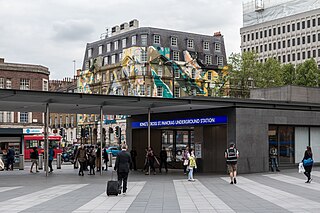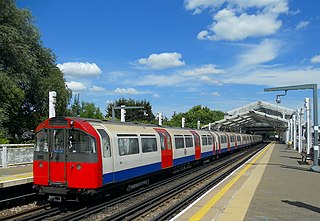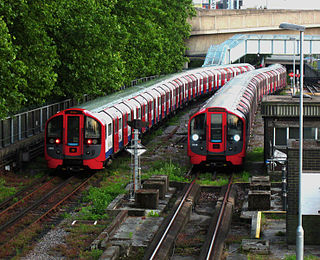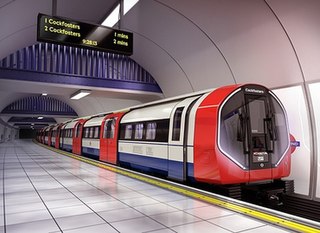
The Docklands Light Railway (DLR) is an automated light metro system primarily serving the redeveloped Docklands area of London and providing a direct connection between London's two major financial districts, Canary Wharf and the City of London. First opened on 31 August 1987, the DLR has been extended multiple times, giving a total route length of 38 km. Lines now reach north to Stratford, south to Lewisham, west to Tower Gateway and Bank in the City of London financial district, and east to Beckton, London City Airport and Woolwich Arsenal. Further extensions are being considered.

The Victoria line is a London Underground line that runs between Brixton in south London and Walthamstow Central in the north-east, via the West End. It is printed in light blue on the Tube map and is one of the only two lines on the network to run completely underground, the other being the Waterloo & City line.

King's Cross St Pancras is a London Underground station on Euston Road in the Borough of Camden, Central London. It serves King's Cross and St Pancras main line stations in fare zone 1, and is an interchange between six Underground lines. The station was one of the first to open on the network. As of 2022, it is the most used station on the network for passenger entrances and exits combined.

The London Underground 1973 Stock is a type of rolling stock used on the Piccadilly line of the London Underground. It was introduced into service in 1975 with the extension of the line to Hatton Cross, followed by a further extension to Heathrow Central in 1977. A total of 86 six-car trains were built.

London Underground rolling stock includes the electric multiple-unit trains used on the London Underground. These come in two sizes, smaller deep-level tube trains and larger sub-surface trains of a similar size to those on British main lines, both running on standard gauge tracks. New trains are designed for the maximum number of standing passengers and for speed of access to the cars.

The London Underground 1992 Stock is a type of rolling stock used on the Central and Waterloo & City lines of the London Underground. A total of 85 eight-car trains were built for the Central line and 5 four-car trains were built for the Waterloo & City line.

London Rail was a directorate of Transport for London (TfL), involved in the relationship with the National Rail network within Greater London, UK which managed TfL's non-London Underground train services.

An elevated railway or elevated train is a railway with the tracks above street level on a viaduct or other elevated structure. The railway may be broad-gauge, standard-gauge or narrow-gauge railway, light rail, monorail, or a suspension railway. Elevated railways are normally found in urban areas where there would otherwise be multiple level crossings. Usually, the tracks of elevated railways that run on steel viaducts can be seen from street level.
Automatic train operation (ATO) is a method of operating trains automatically where the driver is not required or required for supervision at most. Alternatively, ATO can be defined as a subsystem within the automatic train control, which performs any or all of functions like programmed stopping, speed adjusting, door operation, and similar otherwise assigned to the train operator.

The London Underground 1967 Stock was a type of deep-level train that operated on the Victoria line of the London Underground from the line's opening on 1 September 1968 until 30 June 2011. It was also used on the Central line between Woodford and Hainault between 21 February 1968 and 1984, as the same automatic train operation (ATO) system was used on both lines.

The Nuremberg U-Bahn is a rapid transit system run by Verkehrs-Aktiengesellschaft Nürnberg, which itself is a member of the Verkehrsverbund Großraum Nürnberg. The Nuremberg U-Bahn is Germany's newest metro system, having begun operation in 1972, although the Nuremberg-Fürth route (U1) uses part of the right of way of the Bavarian Ludwig Railway, Germany's first passenger railway opened in 1835. The current network of the U-Bahn is composed of three lines, serving 49 stations, and comprising 38.2 kilometres (23.7 mi) of operational route, making it the shortest of the four metro systems in Germany, behind Berlin, Hamburg and Munich.

Docklands Light Railway rolling stock is the passenger trains and service vehicles used on the Docklands Light Railway (DLR), which serves the London Docklands area in the east of London.

The MP 89 is a rubber tired variant of electric multiple units used on the Paris Métro. Designed by Roger Tallon, two types are built by GEC-Alstom for service on Lines 4 and 14, and will soon enter service on Line 6. The trains on Line 1 were moved to Line 4 between 2011 and 2013 to replace the older MP 59s, though only 48 trains are used for revenue service. The remaining four trains are stored either at Montrouge or Saint Ouen as operational spares.

The Brescia Metro is a rapid transit network serving Brescia, Lombardy, Italy. The network consists of a single line, having a length of 13.7 kilometres (8.5 mi) and a total of 17 stations from Prealpino to Sant´Eufemia-Buffalora, located respectively at the north and southeast of Brescia.

Rapid transit or mass rapid transit (MRT), also known as heavy rail or metro, is a type of high-capacity public transport that is generally built in urban areas. A rapid transit system that primarily or traditionally runs below the surface may be called a subway, tube, or underground. Unlike buses or trams, rapid transit systems are railways, usually electric, that operate on an exclusive right-of-way, which cannot be accessed by pedestrians or other vehicles. They are often grade-separated in tunnels or on elevated railways.

The Hitachi Rail Italy Driverless Metro is a class of driverless electric multiple units and corresponding signaling system. Manufactured by Hitachi Rail Italy and Hitachi Rail STS in Italy, it is or will be used on the Copenhagen Metro, Princess Nora bint Abdul Rahman University, the Brescia Metro, the Thessaloniki Metro, Line 5 and Line 4 of the Milan Metro, Line C of the Rome Metro, the Honolulu Skyline system, and the Yellow Line of the Taipei Metro. The first system to use this class of driverless electric multiple units was the Copenhagen Metro which was opened in 2002.

Communications-based train control (CBTC) is a railway signaling system that uses telecommunications between the train and track equipment for traffic management and infrastructure control. CBTC allows a train's position to be known more accurately than with traditional signaling systems. This makes railway traffic management safer and more efficient. Metros are able to reduce headways while maintaining or even improving safety.

The London Underground 2024 Stock, known as the New Tube for London (NTfL) during development, is a London Underground train being built by Siemens Mobility at its facilities in Vienna, Austria, and Goole, United Kingdom. It is part of the Siemens Inspiro family of metro and rapid-transport trains.

The history of automatic train operation includes key dates for system introductions of different Grade of Automation. The lower grades, such as the German Punktförmige Zugbeeinflussung introduced in 1934 have been available earlier. Higher grades, such as the driverless operation have been introduced almost only in case automated guideway transit.















